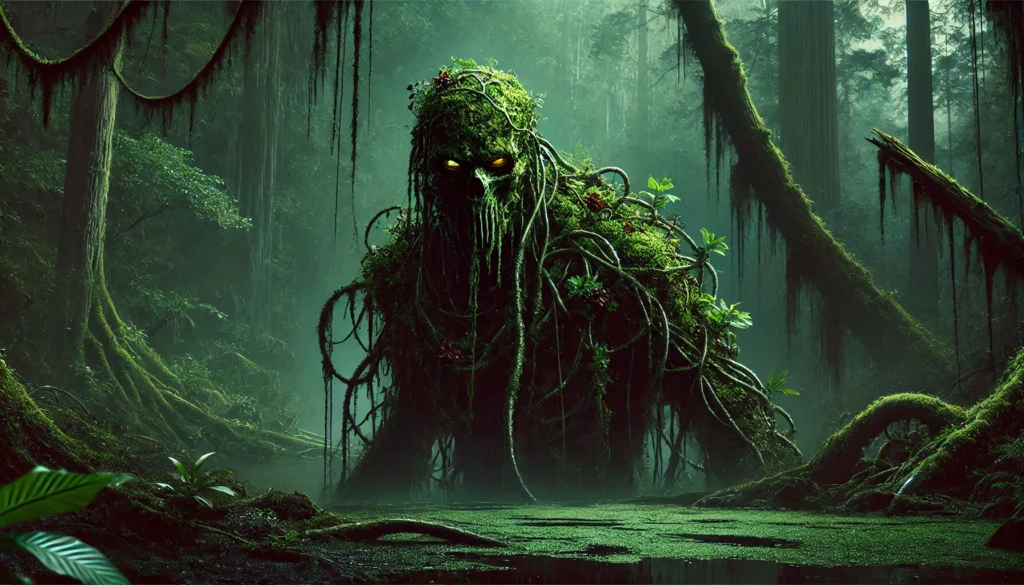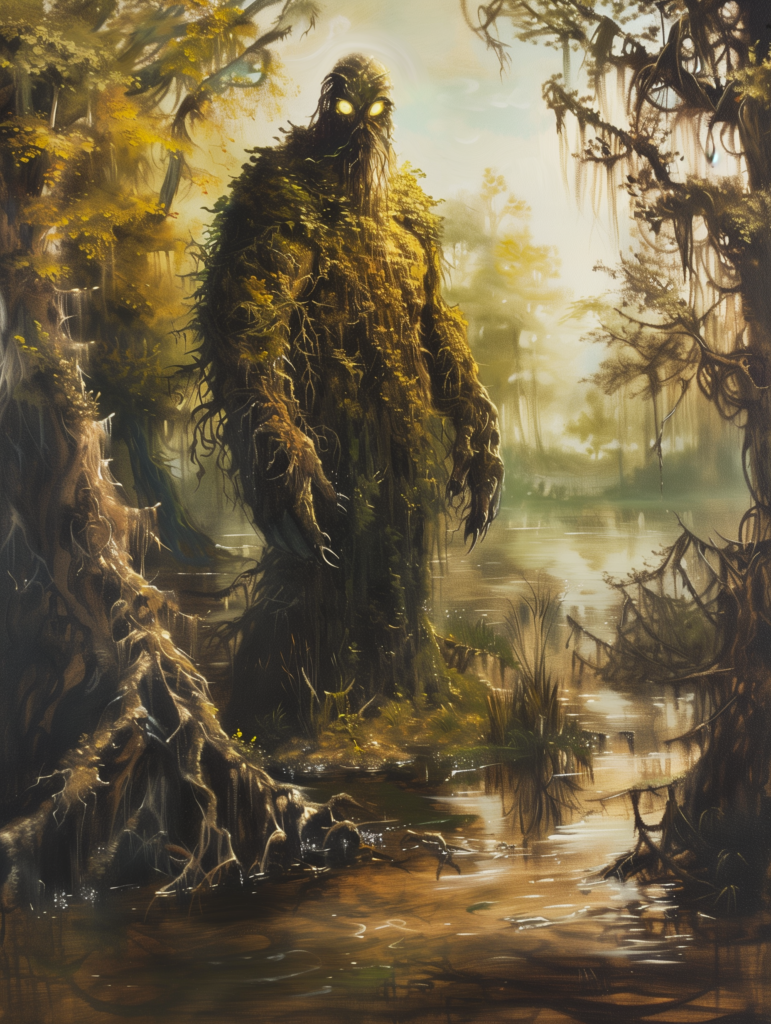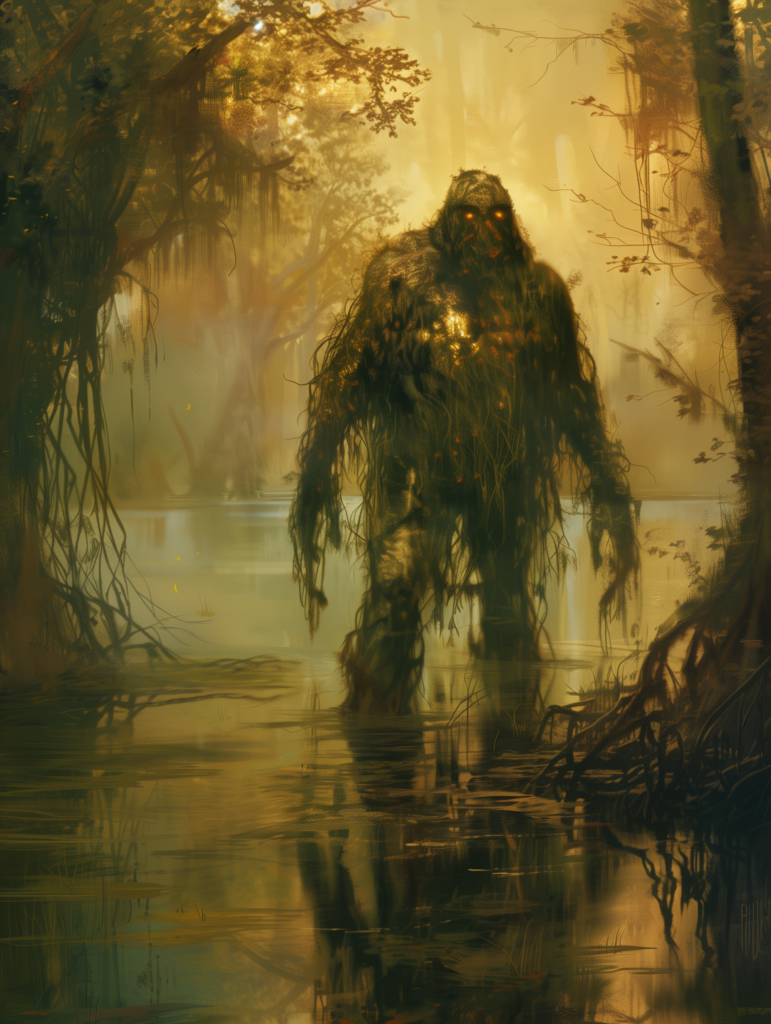Borutas, Guardians of the Marshs
“Unleash the primal fury of the marshlands with Boruta, guardian of nature’s secrets and defender of the untamed wilderness!”

Appearance: Borutas, standing about 7 feet tall and weighing just over 200 pounds, possess a striking resemblance to mossy, skeletal humans. Their bonelike wooden frames, viny coverings, and vivid yellow eyes evoke the essence of ancient forest spirits, shrouded in the mysteries of the marshlands they call home. Their viny flesh often takes on a greenish hue, blending seamlessly with the foliage of their domain, while their leaves darken with age, mirroring the deepening shadows of their secluded habitats.
Behavior: They are guardians of the natural world, hold a deep reverence for the life that thrives within their territories. They view themselves as protectors, kin to the oldest trees and the most delicate blades of grass. Rarely encountered, they prefer the solitude of their marshy domains, tending to the flora and fauna with a gentle yet unwavering hand. Borutas embody the spirits of the land, embodying the wisdom of ages past and the resilience of nature itself.
Habitat: Borutas, born from the depths of bogs and marshes, emerge from isolated pods cocooned in reeds and swampy grasses. Within their protective chambers, they grow and mature, nurtured by the primal energies of the earth. Once fully developed, they emerge as the stewards of their domains, ensuring the balance of life within their marshy realms. Their territories, thick with ancient growth and teeming with life, are sanctuaries untouched by the passage of time.
Modus Operandi: When threatened, they unleash their wrath upon those who would dare to despoil their sacred lands. They defend their territories with ferocity, wielding the forces of nature as their weapons. While they rarely seek conflict, they will not hesitate to retaliate against those who would disturb the harmony of their domains. Borutas are guardians first and foremost, their actions guided by a deep-seated sense of duty to the natural world.
Motivation: Borutas are driven by a profound connection to the land and its inhabitants. They seek to preserve the balance of life within their territories, drawing strength from the rhythms of the earth and the wisdom of the ages. Theirs is a timeless duty, rooted in the traditions of their ancestors and the enduring spirit of the marshlands. As stewards of the natural world, they stand as silent sentinels, guardians of a realm untouched by the passage of time.
Boruta 5e
Boruta Pathfinder
Boruta, Guardian of the Marsh

Large Plant, Neutral
Armor Class: 18 (natural armor)
Hit Points: 210 (20d10 + 100)
Speed: 30 ft., swim 30 ft.
| STR | DEX | CON | INT | WIS | CHA |
|---|---|---|---|---|---|
| 22 (+6) | 14 (+2) | 20 (+5) | 16 (+3) | 18 (+4) | 16 (+3) |
Saving Throws: Str +10, Con +9, Wis +8
Skills: Perception +8, Stealth +7
Damage Resistances: bludgeoning, piercing, and slashing from nonmagical attacks
Damage Immunities: poison
Condition Immunities: charmed, frightened, poisoned
Senses: darkvision 60 ft., passive Perception 18
Languages: Sylvan, Druidic
Challenge: 14 (11,500 XP)
Magic Resistance. It has advantage on saving throws against spells and other magical effects.
False Appearance. While motionless and submerged in water, Boruta is indistinguishable from a natural swamp formation.
Innate Spellcasting. Boruta’s spellcasting ability is Wisdom (spell save DC 16). Boruta can innately cast the following spells, requiring no material components:
- At will: entangle, speak with plants
- 3/day each: plant growth, pass without trace, water walk
Swamp Stride. It can move through difficult terrain composed of natural swamp elements without being slowed or taking damage.
Legendary Resistance (3/Day). If Boruta fails a saving throw, it can choose to succeed instead.
Actions
Multiattack. It makes three vine whip attacks or uses Entangle.
Vine Whip. Melee Weapon Attack: +10 to hit, reach 15 ft., one target. Hit: 16 (3d6 + 6) bludgeoning damage, and the target is grappled (escape DC 16). Until this grapple ends, the target is restrained, and Boruta can’t use the same vine whip on another target.
Entangle. Boruta causes plants in a 20-foot square within 90 feet of it to come to life and grasp at creatures. Each creature in that area must succeed on a DC 16 Strength saving throw or be restrained by the entangling plants until the spell ends. A creature restrained by the plants can use its action to make a Strength check against the spell’s save DC. On a success, it frees itself.
Legendary Actions
Boruta can take 3 legendary actions, choosing from the options below. Only one legendary action option can be used at a time and only at the end of another creature’s turn. Boruta regains spent legendary actions at the start of its turn.
- Move. Boruta moves up to its speed without provoking opportunity attacks.
- Grasping Roots (Costs 2 Actions). Boruta targets one creature it can see within 60 feet of it. The creature must succeed on a DC 16 Strength saving throw or become restrained by grasping roots. The roots vanish after one minute or when Boruta uses this action again.
- Summon Shambling Mound (Costs 3 Actions). Boruta summons a shambling mound. The shambling mound appears in an unoccupied space within 60 feet of Boruta and acts immediately after Boruta in the initiative order. The shambling mound remains for 1 hour, until it dies, or until Boruta dismisses it as a bonus action.
Boruta

Piercing yellow eyes gaze from the mossy skull of this ivy-covered skeleton. Where bones should be, gnarled roots grow, and tangles of vines hang from its moldering chest like spilt viscera.
Though none are sure of the specific relationship between borutas and shambling mounds, the connection is clear when comparing the two, their powers and affinity for the marshlands being the most obvious similarities. Borutas’ or ‘swamp lords,’ as they’re sometimes calledresemble mossy, skeletal humans at first glance, with bonelike wooden frames, viny covering, and vivid yellow eyes.
Considerably more intelligent than their shambling mound cousins, they claim wide territories ‘typically swamps, forests, jungles, or other lands thick with plant-life’ and brook no insult to their realm. Highly defensive of the life within their lands, especially plants and thinking plant creatures, borutas view themselves as the avengers of those that can’t defend themselves, and mercilessly repay destructive invaders with verdurous force. On the rare occasions when they deal peaceably with non-plant creatures, borutas cover their frightening forms with thick veils of grass or peat moss.
Borutas generally stand about 7 feet tall and weigh just over 200 pounds.
| Boruta CR 9 |
| XP 6,400 N Medium plant Init +6; Senses Low-Light Vision; Perception +20 |
| DEFENSE |
| AC 23, touch 13, flat-footed 20 (+2 Dexterity, +1 Dodge, +10 natural) hp 105 (14d8+42) Fort +12, Ref +6, Will +7 Immune electricity, plant traits |
| OFFENSE |
| Speed 30 ft. Melee 2 claws +13 (1d4+3 plus grounding curse) Spell-Like Abilities (CL 7th; concentration +10) Constant–pass without trace At will–entangle (DC 14) 3/day–command plants (DC 17) 1/day–summon nature’s ally V (1 shambling mound only) Spells Prepared (CL 7th; concentration +10) 4th–spike stones (DC 17) 3rd–call lightning (2, DC 16), plant growth 2nd–fog cloud, soften earth and stone, tree shape, wood shape (DC 15) 1st–calm animals, detect animals or plants, goodberry, magic fang, speak with animals 0–create water, detect magic, detect poison, know direction, mending |
| STATISTICS |
| Strength 17, Dexterity 15, Constitution 16, Intelligence 13, Wisdom 17, Charisma 16 Base Atk +10; CMB +13; CMD 26 Feats Combat Casting, Combat Reflexes, Dodge, Improved Initiative, Improved Iron Will, Mobility, Natural Spell Skills Perception +20, Stealth +19, Survival +17 Languages Common, Sylvan SQ treespeech, wild shape |
| SPECIAL ABILITIES |
| Electric Fortitude (Ex) Borutas take no damage from electricity. Instead, any electricity attack used against a boruta temporarily increases its Constitution score by 1d4 points. The boruta loses these temporary points at the rate of 1 per hour. Grounding Curse (Su) Any living creature that takes damage from a boruta’s claws must make a DC 20 Fortitude save or have hundreds of tiny seed pods injected into its body. These seeds grow rapidly; they explode through the victims skin on its next turn, dealing 1d6 points of damage and entangling it as runners and vines grow from its flesh and root themselves in the ground. The victim cannot move unless it makes a DC 10 Strength check to tear the plants from the ground, but doing so also deals 1d4 points of damage to the victim. This effect lasts for 10 minutes. Remove curse, blight, diminish plants, and similar spells instantly end this effect. The save DC is Constitution-based. Treespeech (Ex) A boruta has the ability to converse with plants as if subject to a continual speak with plants spell, and most plants greet them with an attitude of friendly or helpful. Wild Shape (Su) A boruta can wild shape three times per day as a 7th-level druid. In any form a boruta takes, its appearance remains plantlike, with wooden features and leaves rather than fur or feathers. |
| ECOLOGY |
| Environment any Organization solitary, party (2-4), or band (2-4 borutas plus 1-3 shambling mounds) Treasure none |
A distant cousin of shambling mounds, borutas are powerful wielders of natural magic that make their homes in marshes or wetlands, where their mysterious control over the natural environment is most useful.
Ecology

Surfacing from the dark waters of bogs and marshes, borutas are birthed from swamps and forested caves in isolated pods. Cocooned in a thick shell of reeds and swampy grasses, a boruta grows inside its own chamber until it reaches maturity, about 2 years after the emergence of the pod. Upon reaching this stage of maturity, a swamp lord breaks out of its protective shell fully grown.
Though formidable upon emergence, infants are incredibly vulnerable while developing in their cocoons. If the shell-like pod is ruptured before development is complete, the boruta within ceases to grow, usually causing it to simply wither away. Few can say where borutas come from, though some claim that natural lands threatened with destruction or with strong ties to the First World produce them.
Their viny flesh typically takes a greenish hue, though these colors change with the natural progression of the seasons or to otherwise blend in with the foliage of its homeland. As a boruta ages, its leaves continues to darken, and the most ancient swamp lords possess foliage almost as black as the murky waters from which they emerge. How long a boruta might survive, no one knows, as the reclusive creatures sometimes vanish into their fecund homes and aren’t seen for decades. Some propose the creatures are immortalor at least have life spans on par with the oldest treesso long as the territory they watch over remains healthy.
Habitat & Society
Borutas hold plant and animal life in the same esteem as humans typically hold members of their own race or other sentient creatures. As sentient plants, borutas share kinship with the oldest trees and slightest blades of grass in their territories, viewing all as members of their extended family and watching over all.
Their manner of thinking and philosophies differ wildly from these of humanoids, being far more fundamentally tied into the cycle of seasons and the mysterious rhythms of the earth. They understand that nature is rarely calm or peaceful, and that the mere act of moving can often be disruptive or outright destructive to other organisms, yet do what they can to keep forces outside of nature from disturbing or destroying the environments of their homes.
Left to their own devices, they tend to plants and vulnerable animals, commune with the oldest growth and natural creatures of their territories, and encourage new growth. Should their homes be violated, however, whether by the axes of enterprising humanoids or the depredations of rampaging monsters, borutas do all they can to prevent future harm. Sometimes this might mean slaying a dangerous interloper, but in more extreme cases their vengeance might launch an extended campaign of natural violence against an entire community.
Borutas try not to harm the innocent, but if they view certain neighboring creatures as fundamentally destructive, or are forced to choose between the lives of invaders and those of their plants, they will always side with nature. Such decisions often put borutas at odds with expanding humanoid communities, leading to tales of violent swamp monsters or evil spirits of the forest, though rarely do such stories consider the plants points of view.
Borutas are intelligent enough to reason with, but are stolid in their defense of their lands and will no more accept partial loss or brook lessened defilement of their homes than a community might assent to the murder of a mere fraction of its populace.
They rarely encounter others of their kind, being born alone and never leaving their territories of their own accord. They typically find themselves at odds with humanoids, and even the most nature-sensitive elves often find them disagreeable or alien enough to bear avoidance. Druids who know of a boruta in a region typically go out of their way to placate it and serve as peacemakers between the swamp lord and the communities of other humanoids; they often preach avoidance to all who would pass through the proud plant creatures lands.
Despite their similar interests in watching over nature, treants rarely share territories with borutas, preferring highly forested lands while the swamp lords tend to favor darker lands and the meaner plants of the forest. When members of the two races do share lands, they might briefly cooperate in defense of their forest, though treants typically disfavor boruta tactics, which they view as shortsighted and provocative. fey, too, have mixed opinions of borutas, with goodly fey avoiding them, while the more neutral hold them in high regard.
Yet borutas share a special alliance with shambling mounds, treating the wild plants as primitive cousins, often assembling and guiding tribelike communities of the mounds and cooperating with them to drive off those who threaten their lands.
Section 15: Copyright Notice – Pathfinder 44: Trail of the Beast
Pathfinder 44: Trail of the Beast. Copyright 2011, Paizo Publishing, LLC, Author: Richard Pett

 Buy me a coffee
Buy me a coffee